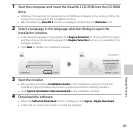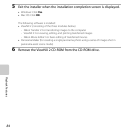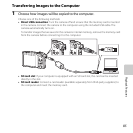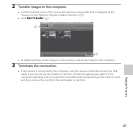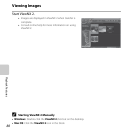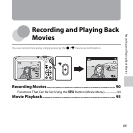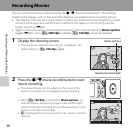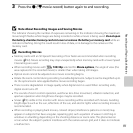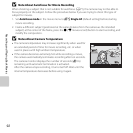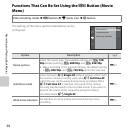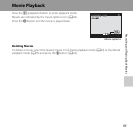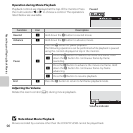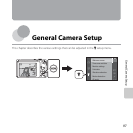
91
Recording and Playing Back Movies
3 Press the b (e movie-record) button again to end recording.
B Note About Recording Images and Saving Movies
The indicator showing the number of exposures remaining or the indicator showing the maximum
movie length flashes while images are being recorded or while a movie is being saved. Do not open
the battery-chamber/memory card slot cover or remove the battery or memory card while an
indicator is flashing. Doing this could result in loss of data, or in damage to the camera or the
memory card.
B Recording Movies
• Memory cards with an SD Speed Class rating of 6 or faster are recommended when recording
movies (F22). Movie recording may stop unexpectedly when memory cards with a lower Speed
Class ratings are used.
• When recording movies with f 720/30p selected for Movie options, the angle of view (the
area captured in the recorded movie) is smaller than when taking still images.
• Optical zoom cannot be adjusted once movie recording begins.
• Rotate the zoom control during recording to enable digital zoom. Subjects can be magnified up to
4× the optical zoom ratio applied before movie recording began.
• There is some degradation in image quality when digital zoom is used. When recording ends,
digital zoom turns off.
• The sounds of zoom control operation, autofocus lens drive movement, vibration reduction, and
aperture operation when brightness changes may be recorded.
• Smear (F3) visible in the monitor with movie recording will be recorded with movies. Avoiding
bright objects such as the sun, reflections of the sun, and electric lights when recording movies is
recommended.
• When recording or playing back movies, colored stripes (interference patterns or moiré) may
appear on subjects that have a regular, repeating grid, such as pattern of weave in clothing or
windows in a building, depending on the shooting distance or zoom ratio. This phenomenon
occurs when the subject’s pattern interferes with the camera sensor grid, and it does not indicate
a malfunction.



